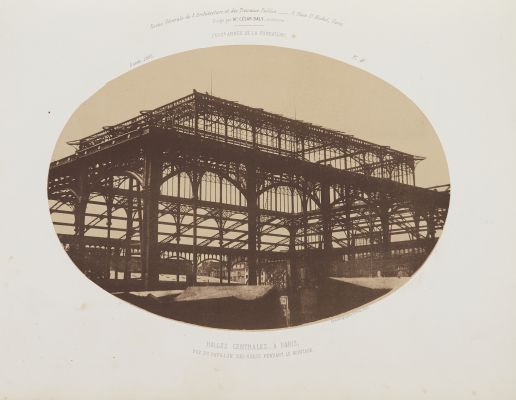
Title
Escalier de Chateau de BloisArtist
Fortier, Alphonse (French, 1825-1882)Publication
Revue Genérale de L'ArchitectureDate
1856Process
Salt PrintAtelier
Blanquart-EvrardImage Size
25 x 19 cm
Salt print from Revue Genérale de L’Architecture (1856). Talbot had patented his calotype process in France, home of the daguerreotype, in 1841, and had made attempts to establish it in Paris; however, the French remained largely uninterested, and his name was little associated with the process. Only in the late 1840s did what was called photography on paper begin to find favor in France. This was principally due to the efforts of Louis-Desire Blanquart-Evrard, a cloth merchant and amateur photographer from Lille, who published his Procedes employes pour obtenir les epreuves de photographie si papier in 1847. The first detailed discussion of calotype to appear in French, it was warmly received. Although his method closely mirrored Talbot’s, Blanquart-Evrard claimed the process as his own and did not acknowledge the accomplishments of any precursor. This omission became the basis of contention between British and French photographers that would last until the early 1850s. [1]
Blanquart- Evrard expounded upon a comprehensive production process that would increase the number of prints that he could produce in a single day from three or four to two- to
three hundred. By employing a division of labor, an assembly line type of factory organization, and his new accelerating chemistry, Blanquart-Evrard believed he stood on the verge of creating industrial means capable of mass-producing photographs. [2]
Reproduced / Exhibited
Jammes, Isabelle. Blanquart-evrard Et Les Origines De L’édition Photographique Française: Catalogue Raisonné Des Albums Photographiques Édités, 1851-1855. Genève: Droz, 1981.no. 534.
Daniel, Malcolm. The Photographs of Edouard Baldus. New York: Metropolitan Museum of Art, 1995. 79.
MET Accession Number: 1990.1101.1
Nelso Atkins Object number: 2008.25.14
References
[1] Taylor R Schaaf LJ Metropolitan Museum of Art (New York N.Y.) Yale University Press National Gallery of Art (U.S.). Impressed by Light : British Photographs from Paper Negatives 1840-1860. New York Washington New Haven: Metropolitan Museum of Art ; National Gallery of Art ; Yale University Press; 2007.
[2] Rosen, Jeff “The Printed Photograph and the Logic of Progress in Nineteenth-Century France”, Art Journal, Vol. 46, No. 4, The Political Unconscious in Nineteenth-Century Art (Winter, 1987)
